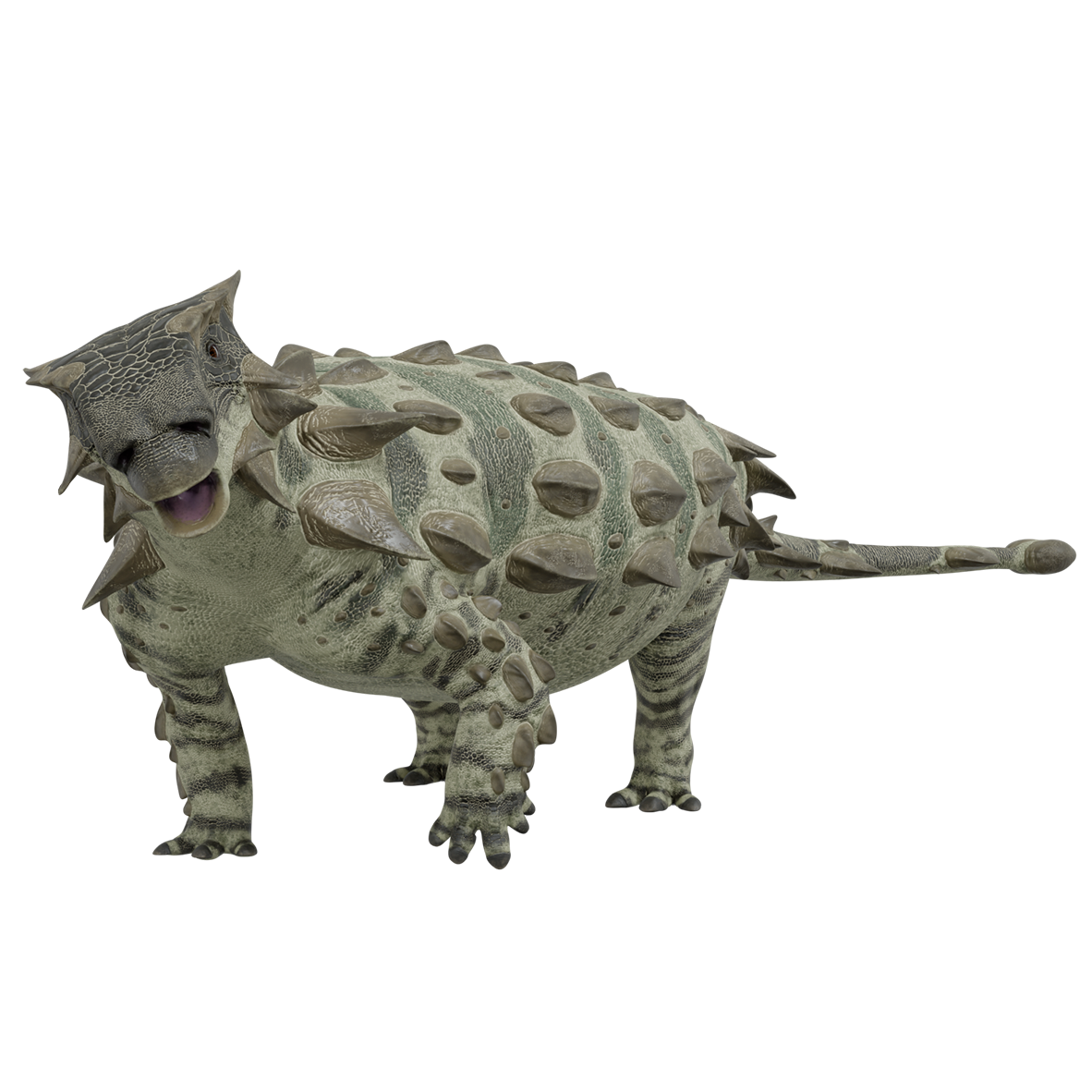The Desert Tanks of Cretaceous Mongolia
Known from multiple complete skeletons, including one with a preserved larynx, this armored herbivore from Mongolia is the best preserved and best represented of all the ankylosaurs!
Overview: Pinacosaurus, discovered in Mongolia in the early 20th Century, is the best-known ankylosaur in the world, known from at least 24 skeletons, plus many more yet to be excavated! These armored herbivores roamed the deserts of Late Cretaceous Mongolia for over 10 million years and may have enjoyed an environment free of large predators. But while large predators may not have been much in evidence, Pinacosaurus nevertheless had to battle the elements in the unforgiving desert, and many seem to have fallen victim to sandstorms, which buried numerous individuals as they hunkered down for protection.
Discovery: Pinacosaurus was discovered in 1923 by Walter W. Granger in the Djadokhta Formation of Mongolia’s Gobi Desert, on an expedition by the American Museum of Natural History. In 1933, Charles Whitney Gilmore described and named it as Pinacosaurus granger, named after Granger, and with a name meaning “plank lizard”, which refers to the small rectangular scute on its head. Since then, many additional specimens have been found in the Djadokhta, Alagteeg, and Bayan Mandahu Formation, including whole bonebeds which have yet to be fully excavated. At least 24 skeletons are known, including juveniles, making Pinacosaurus not only the best-known ankylosaur from Asia, but the best-known ankylosaur in the whole world.
Evolution and Description: Pinacosaurus was an ankylosaurid ankylosaur, meaning it was a close relative of Ankylosaurus and Euoplocephalus, and like these genera, had a tail club. Like all ankylosaurs Pinacosaurus had a very stout body, a small head, and was covered in armored plates in the skin called osteoderms. Like Ankylosaurus, it had a short wide snout. It was a bit small by ankylosaur standards, about 5 meters (16 ft) long, and weighing about 1.9 tonnes (2.1 tons). And while it was stoutly built, it was actually lighter built than other ankylosaurs, and may have been able to move faster.
Behavior and Ecology: 86-71 million years ago, Mongolia was an arid sandy desert sprinkled with occasional rivers and oases. Pinacosaurus was one of the most successful herbivores in this desert landscape. It would have fed low to the ground, and its wide muzzle indicates that it wasn’t especially selective in the plants it ate. This makes sense given its desert environment. Where vegetation was sparse, it would have benefited Pinacosaurus to not be picky.
Pinacosaurus shared its environment with a variety of other dinosaurs, including herbivores like Protoceratops and other ankylosaurs, insect eaters like Shuvuuia, and theropods like troodontids, oviraptorosaurs, and dromaeosaurs (raptors). Velociraptor was one of the most successful predators and may have posed a threat to juvenile Pinacosaurus. However, there are no described remains of large theropods from Pinacosaurus’s environment, with the exception of a few fragmentary remains identified as “indeterminate tyrannosaurids”. It is possible that these large theropods did indeed live and hunt in the desert on Late Cretaceous Mongolia, but these predators may have also been uncommon, given the sparseness of the environment, and perhaps only wandered in from wetter regions. Additional discoveries are needed to be certain. But if there were no or few large predators, then this could explain why Pinacosaurus was more lightly built than its relatives. They may have traded some degree of durability for mobility, in an environment where there were few threats that required such durability.
However, what they lacked in predators, the desert climate made up for. Survival of a large animal in such a harsh ecosystem would have been difficult, plus sandstorms could threaten to bury them, and in fact did at times. Several juvenile Pinacosaurus were discovered huddled together with their legs tucked underneath their bodies. They were probably either resting and got buried by a sandstorm or got caught out in a sandstorm and hunkered down to wait it out but got buried instead. This is also evidence that they formed age-based herds, as all the juveniles were roughly the same age.
In 2023, a fossil larynx (voice box) of Pinacosaurus was reported. It is similar to other reptiles, but with a mechanism that would have allowed more air-flow control like a bird, meaning Pinacosaurus was probably quite vocal and may have had more complex bird-like vocalizations than other reptiles. This also implies that other dinosaurs may have also had bird-like vocalizations.
Extinction and Legacy: Pinacosaurus lived until about 71 million years ago. It is likely that Pinacosaurus went extinct at least in part due to its desert habitat becoming wetter and more forested which happened about the time it went extinct. Additionally, when this local climate shift occurred, large predators, namely Tarbosaurus appeared, or at least became more common, in Mongolia, which Pinacosaurus may not have been equipped to deal with. It was replaced by the ankylosaurs Saichania, with which it coexisted for a few million years and the larger Tarchia. Today, Pinacosaurus can be found in various museums, including the American Museum of Natural History in New York City, New York, USA, the Central Museum of Mongolian Dinosaurs in Ulaanbaatar, Mongolia, and the Paleozoological Museum of China in Beijing, China.
Pinacosaurus FAQ
Pinacosaurus size / How big was Pinacosaurus?
See height, weight, and length.
Pinacosaurus height / How tall was Pinacosaurus?
Pinacosaurus was around 1 meter (3.28 ft) tall.
Pinacosaurus weight / How much did Pinacosaurus weigh?
Pinacosaurus weighed about 1.9 tonnes (2.1 US tons)!
How long was Pinacosaurus?
Pinacosaurus was about 5 meters (16 ft) long!
What did Pinacosaurus eat?
Pinacosaurus ate low-growing plants, and it probably wasn’t picky about which ones.
What is Pinacosaurus's closest living relative?
Like all dinosaurs, the closest relatives of Pinacosaurus are the only surviving lineage of dinosaurs today, the birds. Crocodilians, while not dinosaurs themselves, are also more distant cousins of dinosaurs.
Pinacosaurus family members / Pinacosaurus family / What kind of dinosaur was Pinacosaurus?
Pinacosaurus was an ornithischian (“bird-hipped dinosaur”) in the clade Ankylosauria (armored dinosaurs) and the family Ankylosauridae (armored dinosaurs with tail clubs), making it a close relative of the larger Ankylosaurus from North America.
Where did Pinacosaurus live? / Where was Pinacosaurus found?
Pinacosaurus lived in what is now Mongolia and has been found in the Gobi Desert.
When did Pinacosaurus live?
Pinacosaurus lived about 86.3-71 million years ago during the Late Cretaceous Period.
What does Pinacosaurus mean? / Pinacosaurus name meaning
Pinacosaurus means “plank lizard”.

